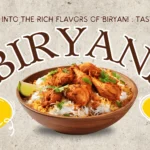Food acts not just as a fuel but rather as a mirror on the stage of culture, history, and innovation. Dramatic human wit, trade, and—more recently—globalization have always characterized the evolution of nutrition and recipes. What is just great about the journey of food—from ancient techniques and culinary practices to modernity—is the way it can transform some simple ingredients into a dish extraordinaire. We are going to dwell on the evolution of food by discussing how traditional recipes evolved over time and from cultural interactions in shaping modern cuisines.
Origins: Ancient Recipes and the First Techniques
Long as humans remained stationary to grow crops, food was part of human culture. First recipes used local ingredients, and preserving methods mainly aimed at nourishment.
1. Ancient Grains and Preservation Techniques
Early civilizations relied mostly on grains, wheat, barley, and rice to sustain them. Their earliest recipes used basic cooking methods of boiling, baking, and fermenting. Just for example, early bread making by the Egyptians consisted of hulled and coarsely ground cereals made into a dough with water and natural leavening.
Example: Egyptian Bread The first breads of the ancient Egyptians were prepared from emmer wheat and baked in clay ovens. Much later, it diversified to include other types of grains and varying leavening methods.
2. Spice Trade and Flavor Development
The spice trade was a catalyst in culinary history. Flavored spices, like pepper, cinnamon, and cloves, were of value everywhere. Because the trading routes were taking place, flavors and ingredients were expanding to countries everywhere.
Example: Indian Biryani – Indian food, Well, biryani is much more than food; it’s actually a festival of flavors and cultural identity. It essentially hails from the Indian subcontinent The dish consists of basmati rice, perfectly marinated meat or vegetables, and a mixture of spices.
The Middle Ages
Regional Specialties and Innovation
More elaborate and colorful were the regional cuisines developed in this era, parallel to the further growth of trades and acquirement from and of all over Europe. Recipes were also starting to get enhanced for bringing out the light from the medieval understanding of cooking techniques and flavor combinations.
1. Medieval Feasts and Preserved Foods
Medieval cuisine was rich, employing preserved foods-such as salted meats, dried fruits, and pickled vegetables-heavy with sauces, and the feasts packed with a great variety of meats, pies, and stews.
Example: Pottage – Supposedly a staple in many a medieval European kitchen, pottage back then meant gruel or a soup that was at once thick and a hodge-podge of what the cook imagined. Conflicting reports had it that pottage could or couldn’t include meat, and it could or couldn’t include enough to satisfy bread-winners.
2. Renaissance Influence and Refined Techniques
What the Renaissance gave way to was consideration for sophistication and refinement in the culinary arts. Increased use of sugar and spices, along with sophisticated techniques like poaching and roasting, began to shine through and herald the then-culinary developments in the now-famous culinary destinations Italy and France.
Example: Ratatouille, the vegetable stew from France, boasts a concentration of fresh, seasonal produce and culinary techniques that denote sophistication in the Renaissance.
The Modern Age
Globalization and Culinary Innovations The contributions of the 19th and particularly the 20th centuries to changing the face of food cannot be overestimated. Technological progress, improvement of transportation, and development of communication have provoked a great level of globalization and intercultural exchange.
1.Industrialization and Convenience Foods
The changes brought on by the Industrial Revolution greatly impact how most people produce and consume their food. Canning, refrigeration, and convenience foods alter how people prepare meals and eat them.
Example: Canned Soup – Invented canned soup, which transformed meal preparation by easily being able to enjoy hearty, flavorful soups with minimal effort.
2. Improvisational Cooking and Fusion Cuisine
The last few decades have created the idea of fusion cuisine. Ingredients and techniques from other cuisines are combined; and this creative strategy is typical of global and the impact of global and other cultural influences on food in more modern times.
Example: Sushi Burrito: Take the basics of Japanese sushi rolled up in a burrito; this is fusion food taken to new levels of creativity.
Classical Recipes: The Dive into the Years Gone By
Even as things on the culinary scene are fast-evolving, there is a closer appeal to cooking using strongly based traditional recipes. Indeed, that gives insight into history and a deep appreciation for the cuisine across cultures.
Example: Italian Risotto — This classic Italian dish has undergone a transformation from very simple beginnings into an elegant, creamy rendition that allows rice to attain its maximum expression and the cook the opportunity to dance with a spoon.
Example: Mexican Mole Poblano — This mole poblano forms a sauce of bold flavor and intense richness holding chilies, chocolate, and spices, therefore expressing profundity in the Mexican tradition of cuisine and the importance of indigenous ingredients.
Cook Ahead: Sustainable, Innovative Cooking
The future continues in an innovative focus on sustainability by creating the future of food, so the chefs of the day, as much as their home cook counterparts, discover new plant-based ingredients, minimize wastage, and try out new technology.
1. Plant-Based and Alternative Proteins
Among many innovations, health and environmental concerns are on the rise, with plant-based and alternative proteins being cooked through innovative ways. Such innovations enable new ways of relishing old tastes and leave behind a smaller carbon footprint on food production.
Example: Impossible Burger – Plant-based way of cooking a beef-styled burger. It further eliminates animal aspects in protein and shows how technology benefits food today in respect to sustainability.
2. Technology and Culinary Arts
Technology does seem to evolve the very way of cooking and the relations we share with food. Helping to raise the crop of culinary capabilities, smart kitchen devices and web-based recipe-sharing platforms bring cooks closer to the world community of chefs and home cooks.
Example: Sous-Vide Cooking: This does the temperature control and distribution evenly during cooking and its process, which is in vacuum-sealed pouches. All this procedure finally results in a perfectly cooked dish with increased flavor intensification.
Conclusion
It’s truly a history of creativeness of humans, cultural exchange, and technological progress. From ancient grains to medieval feasts, through modern fusion and sustainable cuisine of today, there’s some real insight into survivalism and the common past, all the way into the future of what people are going to eat with every step of culinary art evolution. As we further wander into our explorations and innovations, it is food that holds one of the firmest ropes to our past, our diversity celebrations, and our visions of a new future. And so it grows. Whether it’s some newfangledness or another in the venerated recipe or the latest, greatest challenge in the kitchen, each plate tells a tale and adds to the global epic of culinary culture.




Nice Blog